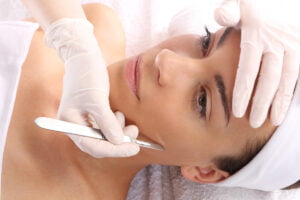The Visia Complexion Analysis System does! This high-tech photography system gives you and your doctor a closer look at your skin. Using ultraviolet and polarized light, it looks deep into the skin to show things happening underneath that can’t be seen with the naked eye or even a magnifying glass.
The machine takes two photos of a patient’s skin. The first one is a highly magnified view of the visible skin — the “Epidermis” — showing visible fine lines, wrinkles, pores, brown spots and unevenness of skin damage. The second photo is taken under ultraviolet light and goes even deeper under the skin to show the “Dermis” and what is developing underneath the outer layers. It’s great for discovering indicators of sun damage that may lead to more wrinkles and spots in the coming years.
Jackie is a 32-year-old mother of two and an avid sun worshipper who admits to wearing as little sun block as possible —SPF 15 on her nose and under her eyes, “because I want to look healthy and tan,” she says. Using the Visia Complexion Analysis System, her doctor could show her exactly the damage those years in the sun have caused. Jackie’s refusal to wear sunscreen, constant sun bathing and squinting may cause premature wrinkles, fine lines, and spots. These issues may be deep within the dermis, and may eventually come to the surface. Before she develops dangerous skin problems like actinic keratoses, Jackie should speak to a doctor about her sun exposure.
Betsy is 55 years old and hates the brown spots that have started appearing on the sides of her face and forehead. She has asked her friends if their skin looks splotchy too and wants to know what all those dark spots are. Worried, Betsy decided to ask her doctor, who explained that Betsy’s discoloration is from her skin cells secreting a pigment called melanin. When you tan, melanin comes to the surface to alter your complexion. Age spots are basically a buildup of pigment from years of sun exposure that continue to grow. They are normally found on the surface of our skin as flat or slightly raised brown spots, but in some cases the damage can go deeper.
Using the Visia Complexion Analysis System, the doctor can tell that Betsy has been wearing sunscreen. Betsy tells the doctor that she has been using SPF 15 for years, which is encouraging, but she still exhibits some long-term sun damage. The doctor takes the second Visia photo to look even deeper into the dermis, which reveals many more sunspots that eventually will come to the surface. Betsey will need to increase her sun protection factor (SPF) and make sure it covers both UVA and UVB rays.
For more information on Visia Complexion Analysis in California, and how you can benefit from this technology, contact us.



